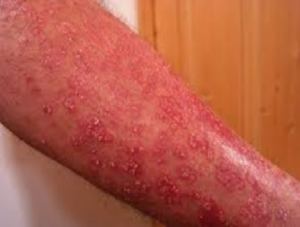Psoriasis

Psoriasis is a skin disorder that causes skin cells to multiply up to 10 times faster than normal. This makes the skin build up into bumpy red patches covered with white scales. They can grow anywhere, but most appear on the scalp, elbows, knees, and lower back.
Psoriasis can’t be passed from person to person. A condition in which skin cells build up and form scales and itchy, dry patches.
Psoriasis is a common, long-term (chronic) disease.
The condition tends to go through cycles, flaring for a few weeks or months, then subsiding for a while. Common triggers in people with a genetic predisposition to psoriasis include infections, cuts or burns, and certain medications.
Psoriasis is thought to be an immune system problem. Triggers include infections, stress and cold .The most common symptom is a rash on the skin, but sometimes the rash involves the nails or joints.
Symptoms:
Skin: rashes, dryness, fissures, flakiness, peeling, small bump, thickness, or redness scaling
Also common: depression, inflamed tendons, itching, joint stiffness, plaque, or small dents in nails. People may experiencepain in the joints.
There are several types of psoriasis, each of which varies in its signs and symptoms:
- Plaque psoriasis: The most common type of psoriasis, plaque psoriasis causes dry, itchy, raised skin patches (plaques) covered with scales. There may be few or many. They usually appear on the elbows, knees, lower back and scalp. The patches vary in color, depending on skin color. The affected skin might heal with temporary changes in color (post inflammatory hyperpigmentation), particularly on brown or Black skin.
- Nail psoriasis: Psoriasis can affect fingernails and toenails, causing pitting, abnormal nail growth and discoloration. Psoriatic nails might loosen and separate from the nail bed (onycholysis). Severe disease may cause the nail to crumble.
- Guttate psoriasis: Guttate psoriasis primarily affects young adults and children. It’s usually triggered by a bacterial infection such as strep throat. It’s marked by small, drop-shaped, scaling spots on the trunk, arms or legs.
- Inverse psoriasis: Inverse psoriasis mainly affects the skin folds of the groin, buttocks and breasts. It causes smooth patches of inflamed skin that worsen with friction and sweating. Fungal infections may trigger this type of psoriasis.
- Pustular psoriasis: Pustular psoriasis, a rare type, causes clearly defined pus-filled blisters. It can occur in widespread patches or on small areas of the palms or soles.
- Erythrodermic psoriasis: The least common type of psoriasis, erythrodermic psoriasis can cover the entire body with a peeling rash that can itch or burn intensely. It can be short-lived (acute) or long-term (chronic).


